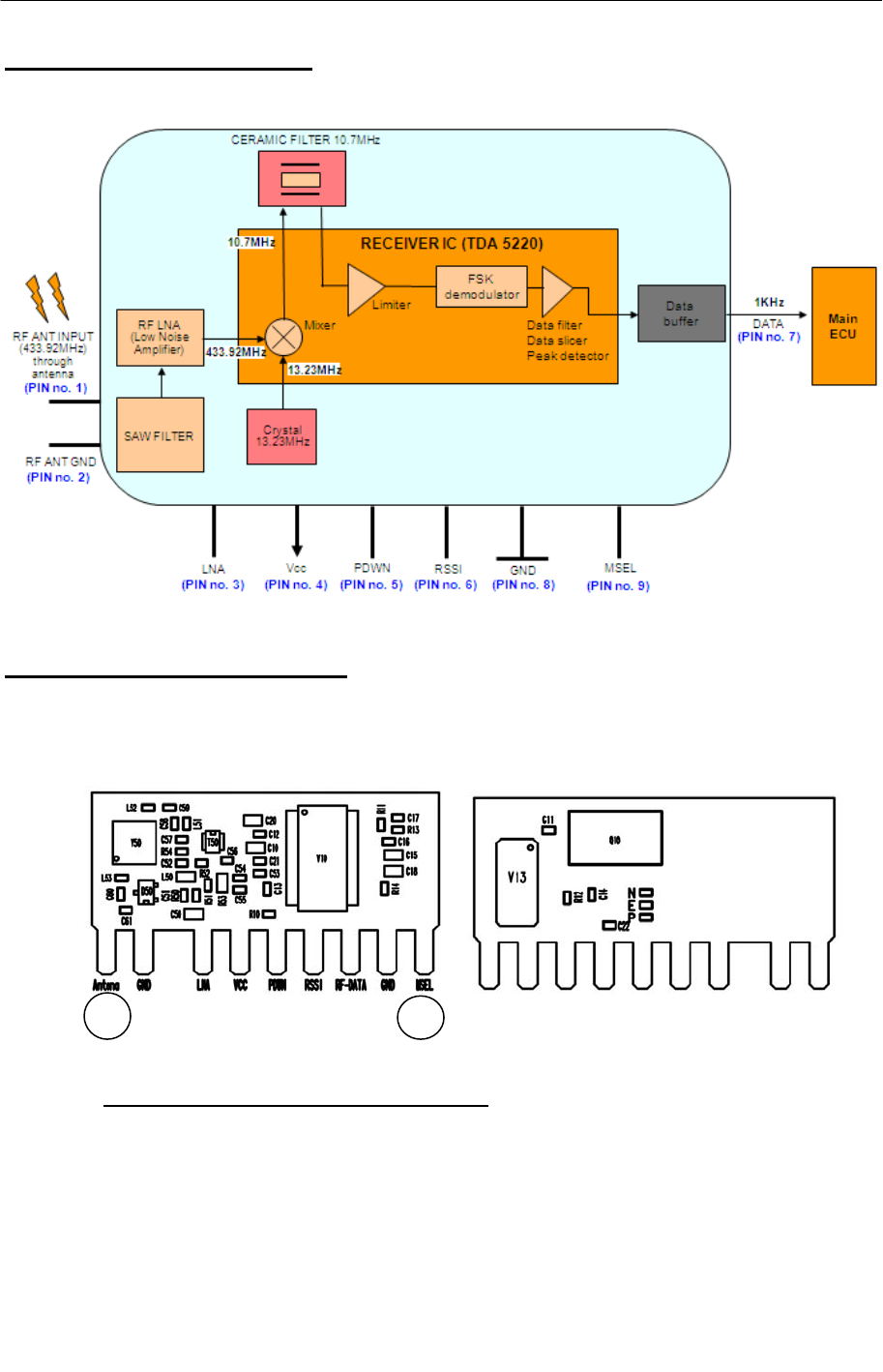Continental Automotive Systems KORX433 Remote Keyless Entry System (Receiver) User Manual Function Kor Rx 5WY8231
Continental Automotive Systems Corporation Remote Keyless Entry System (Receiver) Function Kor Rx 5WY8231
User Manual

Continental Automotive I BS PG3 WL
Page 1 of 6
User Manual / Functional
Description
of
RF Receiver module
Type: SVI-KORX433(433.92MHz)

Continental Automotive I BS PG3 WL
Page 2 of 6
1. General information
This Korean RF Receiver is used for RKE functions on vehicles.
The receiver principle is super heterodyne PLL frequency synthesizer and designed
for the reception of 1KHz Manchester codes with only FSK signal optimized.
The Center frequency are 433.92MHz(5WY8231, NA).
This receiver has oriented enhanced RF LNA characteristic to improve RF sensitivity
instead of internal LNA part of InfineonTDA 522x provided.(removed internal LNA)
The receiver module is best optimized SAW filter, External LNA and 1K data baud
filtering for data band spectrum noise characteristic.
This receiver has 9 leg’s(1.Antenna input, 2.GND- antenna, 3.LNA- power supply,
4.Vcc-power supply, 5.PWDN, 6.RSSI, 7.DATA-output, 8.GND, 9.MSL)
which will be united to SRX PCB by wave soldering.( stick into main PCB by hand).
1.Operating temperature range
-40 ºC < T < +85 ºC
2. Technical Data
All data is specified at T= 25 °C (RT) and VCC = 5V
3. VCO – Frequency
Frequency
Variants VCO frequency Tolerance
T=-40 ºC to +85 ºC
433.92MHz, 846.44MHz ± 90ppm
4. Input Sensitivity
Input sensitivity at center frequency, BER 10 -2 (Vcc=5V)
FSK:
fmod = 1 kHz square- wave +/-35KHz deviation.
Variants Description Condition Typ min unit
5WY 8231 433.92MHz,
FSK,1K FSK ,Fmod=1KHz -110 ≤ -107 dBm

Continental Automotive I BS PG3 WL
Page 3 of 6
4.1 Sensitivity Variation over temperature
4.2 FSK frequency-deviation
Max .FSK deviation F= ±120 kHz
Min. FSK deviation 1k variants F = ± 10 kHz
For the min. sensitivity, under the degraded Freq-deviation less than 30 KHz, could be allowed within 3dB.
5. Current Consumption; Vcc = 5 V (RT)
(no RF – signal applied to the receiver input)
5.1 Current consumption
V
cc = 5 V,
No RF signal applied at RF input
5.2 Active current (Switching High) with LNA
@ T=25ºC (RT):
FSK Is < 9.1 mA
@T=-40 to +85°C
FSK Is < 9.3 mA
5.3 Standby current (switching Low) with LNA
@ T=-40 to +85°C Is < 5 µA
The power supply is not ESD protected.
This protection must be done on the main board (ECU).
Sensitivity Variation T=-40 to 85°C: normal sense @ RM ≤ ±3dB

Continental Automotive I BS PG3 WL
Page 4 of 6
6. Schematic Block diagram
7. Physical Layout information
7.1 I/O pins layout
KOR-baby-Rx I/O pin configuration
1- Antenna input
2- GND- antenna
3- LNA- power supply
4- Vcc-power supply
5- PWDN
6- RSSI
7- DATA-output
8- GND
9- MSEL
1 9
<Top side vieww> <Bottom side view>

Continental Automotive I BS PG3 WL
Page 5 of 6
8. Homologation labelling
8.1 Model name : SVI-KORX433
8.2 USA(433.92MHz) : SY5KORX433
8.3 CANADA(433.92MHz) : 8325A-KORX433
8.4 Homologation statement
FCC Compliance Statement.
This device complies with part 15 of the FCC Rules.
Operation is subject to the following two conditions :
(1) This device may not cause harmful interference, and
(2) This device must accept any interference received, including
interferencethat may cause undesired operation.
This equipment has been tested and found to comply with the limits for a Class B
digital device, pursuant to part 15 of the FCC Rules. These limits are designed to
provide reasonable protection against harmful interference in a residential installation.
This equipment generates, uses and can radiate radio frequency energy and, if not
installed and used in accordance with the instructions, may cause harmful
interference to radio communications. However, there is no guarantee that
interference will not occur in a particular installation. If this equipment does cause
harmful interference to radio or television reception, which can be determined by
turning the equipment off and on, the user is encouraged to try to correct the
interference by one or more of the following measures:
- Reorient or relocate the receiving antenna.
- Increase the separation between the equipment and receiver.
- Connect the equipment into an outlet on a circuit different from that to which the
receiver is connected.
- Consult the dealer or an experienced radio/TV technician for help.
Do Not
Any changes or modifications to the equipment not expressly
approved by the party responsible for compliance could void
user’s authority to operate the equipment.

Continental Automotive I BS PG3 WL
Page 6 of 6
IC Compliance Statement.
Le present appareil est conforme aux CNR d’Industrie Canada applicables aux
appareils radio exempts de licence. L’exploitation est autorisee aux deux conditions
suivantes :
(1) l’appareil ne doit pas produire de brouillage, et
(2) l’utilisateur de l’appareil doit accepter tout brouillage radioelectrique subi,
meme si le brouillage est susceptible d’en compromettre le fonctionnement.
This device complies with Industry Canada licence-exempt RSS standard(s).
Operation is subject to the following two conditions:
(1) this device may not cause interference, and
(2) this device must accept any interference, including interference that may
cause undesired operation of the device.